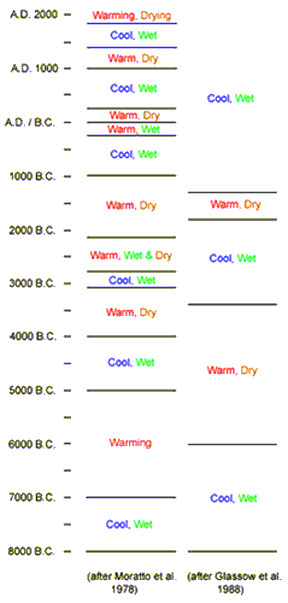Paleoclimates
San Diego County’s climate varied during the period of human occupation. Climatic factors, particularly temperature and rainfall, influenced the character of human adaptations, both directly and by shaping the local fauna and flora. Reconstructing past climates and patterns of climatic change may be one key to interpreting regional prehistory.
Several models have been advanced for the Holocene climatic prehistory of California:
- In an early, influential, but also controversial synthesis, Ernst Antevs (1948) distinguished three major Holocene climatic phases for western North America: Anathermal, 7000-5000 B.C., which was cooler and moister than the present; Altithermal, 5000-2000 B.C., warmer and drier than the present; and Medithermal, after 2000 B.C., with modern climatic conditions.

- For central California, Michael J. Moratto, Thomas F. King, and Wallace B. Woolfenden (1978) projected two major Holocene temperature trends: warming until about 1000 B.C., and then cooling during the last 3,000 years. A dozen or so shorter-term warm or cool and wet or dry episodes were also hypothesized. The archaeological record of the southern Sierra Nevada was examined for possible reflections of the climatic changes in social complexity, political organization, population density, settlement patterns, and exchange systems. The applicability of this model farther south is open to question.– For the Santa Barbara Channel, Michael A. Glassow, Larry Wilcoxon, and Jon Erlandson (1988) offered a detailed paleoclimatic model that was often at variance with that of Moratto and his associates.
- Larry A. Carbone (1991) reviewed evidence from southern California for a warming and drying trend in the early Holocene (after ca. 8,000-7,300 radiocarbon years before the present).
- G. James West, Wallace Woolfenden, James A. Wanket, and R. Scott Anderson (2007; see also Jones and Klar 2007) discussed evidence concerning the prehistoric climates within various regions of California based on proxy records, including marine fossils and isotopes, tree rings, Neotoma (packrat) middens, and pollen. General climatic benchmarks that were recognized included the cool conditions of the early Holocene Younger Dryas, the middle Holocene temperature maximum, the Medieval Climatic Anomaly, and the Little Ice Age.
- Recent studies have particularly focused on climatic variability during the final millennium of prehistory, including the Medieval Climatic Anomaly (ca. A.D. 800-1350). Drought conditions in many parts of western North America have been linked to changes in subsistence strategies, demographic trends, exchange patterns, and interethnic violence (Jones et al. 1999). Matthew A. Boxt, L. Mark Raab, Owen K. Davis, and Kevin O. Pope (1999) examined late climate change on the southern California coast, primarily in Los Angeles County. They found “ecological catastrophes and extreme weather conditions, including prolonged droughts during the Medieval Climatic Anomaly (between about A.D. 900 and 1300), and dramatically increased moisture levels associated with the Little Ice Age after about A.D. 1300.”A variety of non-archaeological methods have been applied to the reconstruction of paleoclimates in southern California. These include studies of marine cores, pollen, tree rings, and packrat middens. Additionally, several archaeological approaches to the problem have been employed:
- Shellfish species distributions. The latitudinal ranges of particular shellfish species are influenced by water temperature, which in turn reflects, at least in part, the local air temperature. Carl L. Hubbs and his collaborators (Hubbs and Bien 1967; Hubbs et al. 1960, 1962, 1965; Shumway et al. 1961) used the associations between radiocarbon dates and the individual shellfish species present in archaeological middens, the general range of species represented, and the average size of specimens to make inferences about paleoclimates.
- Marine fish species distributions. The ranges of marine fish are similarly influenced by temperature. “Zooarchaeological research on the fish remains from aboriginal sites along the southern portion of the [southern California] bight does not support the [Holocene] climatic change hypothesis. The analysis of over 95,668 piscine elements, identified to at least genera and recovered from 23 sites (ranging in age from 9,775 years BP to the Spanish Mission Period), disclose no perceptible environmental change from present fish-habitat communities” (Salls 1988:51).
- Oxygen isotope analysis. Henry C. Koerper, John S. Killingley, and R. E. Taylor (1985) used oxygen isotope studies of Mytilus shells from ORA-855 in San Juan Capistrano to support a conclusion that water temperatures on the southern California coast dropped 3o C below present levels during the “Little Ice Age” (ca. A.D. 1400-1850). They concluded that aboriginal subsistence was not adversely affected by the cooler and probably moister conditions.
- Pollen analysis. Local pollen analyses have had little success in demonstrating convincingly either climatic change or stability, in part because of poor pollen preservation and a general uncertainty about the stratigraphic integity of pollen columns. However, several pollen studies have shown promise, including work at Las Flores Creek (Anderson 1996; Anderson and Byrd 1997; Davis 2003) and at Los Peñasquitos Lagoon (Cole and Wahl 2000).
- Site locations. Climatic changes may be inferred from the presence of archaeological sites in locations that would have been inhospitable under modern climatic conditions, or from the absence of sites dating from particular periods in areas exploited during other periods. In the Colorado Desert, it has been suggested that a near-absence of Archaic Period sites may reflect an abandonment of much of the region under altithermal conditions (cf. Rogers 1939; Wallace 1978). Some coastal occupations suggested to Hubbs and his collaborators a greater availability of fresh water, and therefore greater rainfall, during earlier periods than under present conditions.
PROSPECTS
Future archaeological investigations and non-archaeological paleoenvironmental studies may be able to document in more detail the patterns of change in prehistoric climates and their correlation with changes in human adaptative strategies within the region.